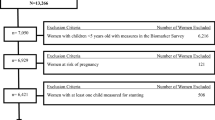Abstract
We examined the association between women’s/children’s duration of WIC participation and household food security status. For mothers (n = 21,863) and their children (n = 57,377) participating in WIC (2001–2006), longitudinal measures of household food security status were collected using a subscale of the USDA Food Security Module. Using logistic regression, household food security status at the last WIC visit was associated with measures of WIC duration (number of trimesters on WIC for pregnant women, and number of WIC visits for children). Among women with prenatal household food insecurity with hunger, odds of any post-partum household food insecurity was reduced with first (AOR = 0.67, 95% CI = 0.48–0.94) or second trimester of entry (AOR = 0.64, 95% CI = 0.45–0.90) versus third. Among children with initial household food insecurity without hunger, an additional WIC visit reduced the odds of any household food insecurity (AOR = 0.92, 95% CI = 0.90–0.94) and of household food insecurity with hunger (AOR = 0.94, 95% CI = 0.89–0.98) at the last visit. Among those with initial household food insecurity with hunger, an additional WIC visit reduced the odds of any household food insecurity (AOR = 0.96, 95% CI = 0.92–0.99) and of household food insecurity with hunger (AOR = 0.88, 95% CI = 0.83–0.94) at the last visit. Earlier and longer WIC participation may improve household food security status, particularly of vulnerable groups.
Similar content being viewed by others
Notes
As of 2006 the USDA modified the terminology from food insecurity with and without hunger to low food security and very low food security [3].
References
Anderson, S. A. (1990). Core indicators of nutritional state for difficult-to-sample populations. Journal of Nutrition, 121, 1559–1600.
Nord, M., Andrews, M., & Carlson, S. (2009). Household Food Security in the United States, 2008. Economic Research Report No. (ERR-83), pp. 66. Available at: http://www.ers.usda.gov/Publications/ERR83/ERR83.pdf.
http://www.ers.usda.gov/briefing/foodsecurity/labels.htm. Accessed 24 April 2009.
Devaney, B., Bilheimer, L., & Schore, J. (1992). Medicaid costs and birth outcomes: The effects of prenatal WIC participation and the use of prenatal care. Journal of Policy Analysis and Management, 11(4), 573–592.
Besharov, D., & Germanis, P. (2001). Rethinking WIC an Evaluation of the Women, Infants, and Children Program. Washington, DC: American Enterprise Institute Press.
Bitler, M., Gundersen, C., & Marquis, G. S. (2005). Are WIC nonrecipients at less nutritional risk than recipients? An application of the food security measure. Review of Agricultural Economics, 27(3), 433–438.
Wilde, P. E., & Peterman, J. N. (2006). Individual weight change is associated with household food-security status. Journal of Nutrition, 136, 1–6.
Herman, D. R., Harrison, G. G., Afifi, A. A., & Jenks, E. (2004). The effect of the WIC program on food security status of pregnant, first-time participants. Family Economics and Nutrition Review, 16, 21–30.
Andrews, M. (2007). Unpublished data, US Dept. of Agriculture.
Office of Analysis and Evaluation. (1997). Household Food Security in the United States in 1995: Technical Report of the Food Security Measurement Project. Washington, DC: US Department of Agriculture, Food and Consumer Service.
Bickel, G., Nord, M., Price, C., Hamilton, W., & Cook, J. (2000). Guide to measuring household food security, revised 2000. Alexandria, VA: US Department of Agriculture, Food and Nutrition Service.
Nord, M., Sherry, B., & Grummer-Strawn, L. M. (2002). Analyses of comparison of the sensitivity, specificity, and positive predictive value of the threshold subscale to the 18-question food security module among household with children with incomes <185% of poverty (Unpublished).
Casey, P., Goolsby, S., Berkowitz, C., Frank, D., Cook, J., Cutts, D., et al. (2004). Maternal depression, changing public assistance, food security and child health status. Pediatrics, 113(2), 298–303.
Hanson, K. L, Sobal, J., & Frongillo, E. A. (2007). Gender and marital status clarify associations between food insecurity and body weight. Journal of Nutrition, 137(6), 1460–1465.
Jyoti, D. F., Frongillo, E. A., & Jones, S. J. (2005). Food insecurity affects school children’s academic performance, weight gain, and social skills. Journal of Nutrition, 135, 2831–2839.
Skalicky, A., Meyers, A., Adams, W., Yang, Z., Cook, J., & Frank, D. (2006). Child food insecurity and iron deficiency anemia in low-income infants and toddlers in the United States. Maternal and Child Health Journal, 10, 177–185.
Rose-Jacobs, R., Black, M., Casey, P., Cook, J., Cutts, D., Chilton, M., et al. (2008). Household food insecurity: Associations with at-risk infant and toddler development. Pediatric, 121, 65–72.
Cook, J., Frank, D., Berkowitz, C., Black, M., Casey, P., Cutts, D., et al. (2004). Food insecurity is associated with adverse health outcomes among human infants and toddlers. Journal of Nutrition, 134, 1432–1438.
Winicki, J., & Jemison, K. (2006). Food insecurity and hunger in the kindergarten classroom: Its effect on learning and growth. Contemporary Economic Policy, 21, 145–157.
Acknowledgments
We would like to gratefully acknowledge the Economic Research Service of the USDA for providing the funding for this research and the following individuals for their contribution to this project: (1) Lucia Kaiser and Tammy McMurdo, UC Davis RIDGE. (2) Mark Nord, ERS USDA. (3) Bettylou Sherry, CDC. (4) Mary Kelligrew Kassler, formerly Director- Nutrition Division and Massachusetts WIC, and WIC program staff and participants. (5) Joshua Nyambose, Data cleaning and management.
Author information
Authors and Affiliations
Corresponding author
Rights and permissions
About this article
Cite this article
Metallinos-Katsaras, E., Gorman, K.S., Wilde, P. et al. A Longitudinal Study of WIC Participation on Household Food Insecurity. Matern Child Health J 15, 627–633 (2011). https://doi.org/10.1007/s10995-010-0616-5
Published:
Issue Date:
DOI: https://doi.org/10.1007/s10995-010-0616-5




